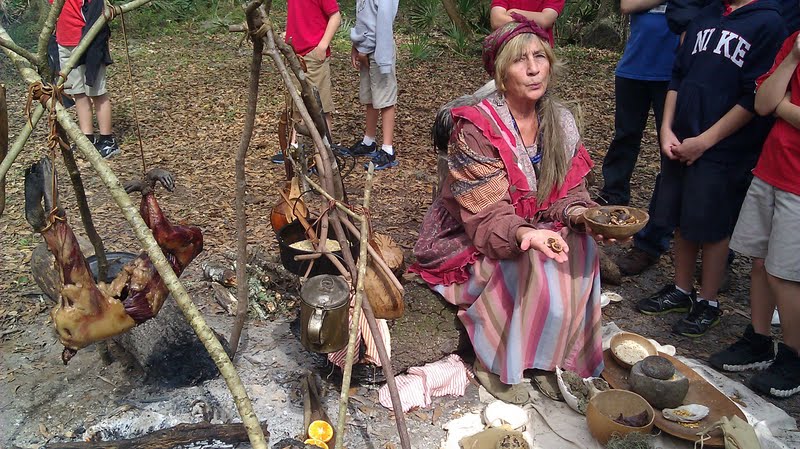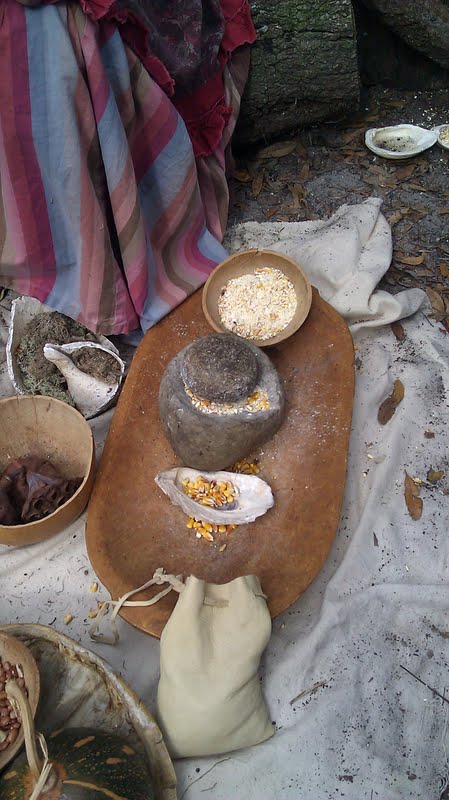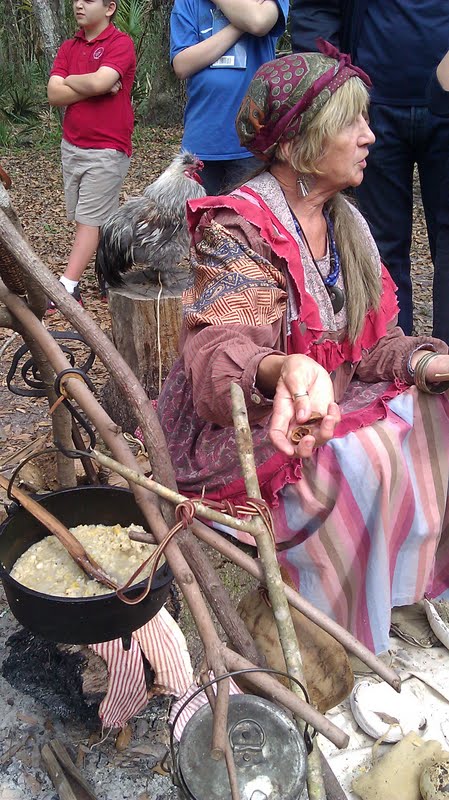Table of Contents[Hide][Show]

The Native American tribe known as the Seminoles of Florida consumed a varied and interesting traditional diet with soaked corn gruel and wild animal meat as primary staples.
The Seminoles were the dominant Native American force in Florida during the colonization of the area by European settlers during the 18th and 19th centuries.
Each year, Fort Foster at Hillsborough River State Park hosts a living history exhibit where schoolchildren can come and learn about the Second Seminole War, also called the Florida War, which occurred from 1835 -1842 between the United States and the Seminoles.
My child’s class took a field trip to Fort Foster to experience the living museum firsthand, and I was excited to tag along as one of the chaperones.
Seminoles Ate Meat
Every facet of life during this period for both the American soldier and Seminole Indians was covered in detail as one walked around the Fort as well as the tribal settlement located across the pristine waters of the Hillsborough River via a wooden bridge.
While all aspects of the living museum proved interesting, I was particularly fascinated by the traditional foods of Native Americans living in Florida at that time as demonstrated by a lady dressed in Seminole attire who thoroughly explained how the tribe nourished themselves on a daily basis.
In the picture above, you can see an animal roasting over a fire.
The kids and chaperones had a fun time trying to guess what the animal was, but we all were wrong even though the claws are a dead giveaway that the animal is a raccoon!
Raccoons supposedly taste like, you guessed it, chicken!
Not boneless, skinless chicken breasts, mind you, but the dark meat, which is mineral-rich and full of very nourishing fat.
Soaked Corn. A Staple of the Seminole Tribe

The dish that really caught my eye, however, was the soaked corn gruel that served as the mainstay of the Seminole tribe diet.
The corn was pounded into a coarse, cracked flour, soaked in weak lye water obtained from wood ash, and then cooked over low to medium heat for 3-4 hours into a soup called sofkey.
The lye increased the nutrient availability of the corn, most notably Vitamin B3 or niacin. Since sofkey was the mainstay of the Seminole diet, the release of the niacin from the corn via soaking was absolutely critical to health.
Pellagra, a vitamin B3 (niacin) deficiency disease is a devastating illness that can result in death following progressively worsening symptoms of diarrhea, dermatitis, and dementia. Soaking corn in limewater prior to cooking alleviated the risk of this illness.
Sofkey is sour to the taste indicating that the corn was fermented as well as soaked further improving digestibility and nutrient absorption for the Seminoles.
The Seminole Tribe in Florida was never completely defeated by the United States with several hundred individuals hiding out in the Everglades indefinitely eluding attempts to round them up and ship them off to an Oklahoma reservation.

The Seminole tribe living in Florida today is quite proud of the fact that they were never officially conquered which played a role in the recognition of the tribe’s sovereign rights by the federal government in 1957.
No doubt, the Seminole tribe’s wise and careful preparation of their grain-based foods proved a deciding and critical factor in their ability to evade and resist resettlement by the United States government for over a hundred years all the while remaining healthy and strong.
If you live in the West Central Florida area, you can still visit the living history museum at Fort Foster in Pasco County.








I think you have proven the point that “preparing grains in a traditional way” if neccessary. If every person eatting grains would take the proper steps to properly prepare grains then maybe they wouldn’t be so offensive or gut-renching. I doubt that many people will go through the process on a regular basis. Were your intention to prove the Paleo/Primal point? It seems you have. Thanks.
How hard is it to soak a bowl of rice or oatmeal?
Most people that are Primal are drawn to the 80/20 rule. We all sacrifice on something. I can’t stand the cravings it causes so I choose to avoid it. I also have pretty bad belly issues when I eat grains.
“how hard it is to soak”? You have to soak them for a significant period of time. To me it isn’t worth the end result. And even then I still suffer some side effects.
Don’t get me wrong, every few months I cave to see if I’m missing something special. I’m almost always sorry I did.
Sarah, have you ever tried it to see how you feel after? You might be surprised. You might actually experience the same benefits we are boasting about.
Please don’t take it as us against you. I’m against fast foods, modified foods and conventional wisdom. Not grains. If you eat them and feel good then carry on. But try it before you knock it.
I was grain free for 5 months last year when my husband was on GAPS. I am definitely better on grains as are most people who have their guts in order. If your gut is messed up, then stay off the grains, but this does not make grains bad.
I consider myself primal, and I eat a very balanced diet of fruit, vegetables, meats, nuts and seeds. And occasionally a nice big bowl of steel-cut oatmeal with lots of cream on wintry mornings ;). My diet isn’t restrictive and I don’t like being lumped in with vegans. Being active in the paleo/primal blogosphere, yes I have seen many people saying “grains are teh badz!”, but they are not judgemental of those who do eat them, and always respond politely (at least at first) to the inevitable vegan trolls. Try getting that respect from a vegan site like 30BaD. Point is, I don’t like being lumped in with crazies for choosing not to eat grains (mostly), and I don’t judge people who do eat grains. I think they are fine for some, if your digestion is healthy and you are not insulin sensitive. I just mainly choose to avoid them, because it’s easier and I feel better that way. Nothing wrong with that, right? We are all Real Food friends here, after all!
Anyway, I will be glad when this whole How to Prepare Grains webinar is over because it has taken over the Real Food blogosphere! Seriously, almost every post I have read for the past week has been about how GRAINS IS GOOD (join our webinar!!!). Not trying to troll, and I love your blog, just saying I’m looking forward to some different topics soon!!
That’s ok, that’s one thing I like about your blog :). I don’t think I or anybody needs to be defensive about our diets, and I don’t think there is anything wrong with any whole, natural food as long as care is taken to prepare it properly. Me, I feel much better without grains (and I certainly don’t want to depend too much on them the way SAD so often does), but it’s important for people to experiment and find what makes them feel the best. A lot of factors are involved, after all. One reason I think that having oats sometimes is ok for me is that I am of Scottish extraction :).
This is slightly off topic but relevant to the grain topic so I figured I would pass it along.
Great article I just read that was linked on Jill’s (Real Food Forager) recent grain related post. There is a big difference in how our bodies metabolize glucose and fructose. The carb/sugar glucose content (in bread) is metabolized by all of our bodies’ cells vs. fructose being metabolized by our liver. Therefore the insulin resistance a lot of us are experiencing comes mainly from consuming too much sugar. Which is usually 50/50 glucose/fructose where bread/carbs are straight glucose. I personally will be researching more about this as I am a sugar-aholic desperately trying to cut the crap.
I think grains are good in a diet if prepared properly and for those that are celiac avoid gluten, but still try to include other grains because they are not only healthy but usually available in bulk and more affordable.
https://www.nytimes.com/2011/04/17/magazine/mag-17Sugar-t.html?pagewanted=1&_r=1
think you Sarah, I love historical posts just as I liked Prince’s book.
I think it is very hard for people to find the time to prepare grains properly. That is why we eat white rice, and I buy sourdough rye bread an buckwheat from a Polish store, and try to bake with more digestible flours other than whole wheat. I found that I simply do not have the time to prepare grains traditionally.
Sure, I get that. It’s good that you have found a way to make it work rather than writing them off and rationalizing to yourself incorrectly that “grains are bad” which is a fallacy that is easily identified simply by examining healthy traditional cultures such as the Seminole tribe.
My point is that it is being put out that hybridization doesn’t change the wheat plant and that is incorrect information. Pg 38, Hybridization efforts of the past fifty years have generated numerous additional changes in gluten-coding genes in Triticum aestivum, most of them purposeful modifications of the D genome that confer baking and aesthetic characteristics on flour.(16) Indeed, genes located in the D genome are those most frequently pinpointed as the source of the glutens that trigger celiac disease. (17)
16. Shewry PR, Halford NG, Belton PS, Tatham AS. The structure and properties of gluten: an elastic protein from wheat grain. Phil Trans Roy Soc London 2002; 357:133-42.
17. Molberg et al. Gastroenterol 2005;128:393-401.
Possibly with the GAPS diet this autoimmune disease could be mediated but if you are a celiac I think most of us would prefer to avoid wheat rather than chance that it has been cured. It was once believed that celiac could be outgrown and that is now known not to be true. With the devastation that it does to the body I don’t believe that it is worth the risk but that is my decision and everyone is different.
Sure, I can understand if a celiac prefers to just avoid gluten rather than risk it after a period of healing. That is a personal choice. What I am vehemently opposed to is when folks who can’t handle wheat or grains somehow try to make the rest of us believe that this is the way humans are supposed to eat and that grains are a villain food. Complete rubbish!
This may be true… BUT normal wheat based flour doesn’t have enough gluten to make good bread. That’s why you can buy “bread flour” or additives to add to regular flour in order to make bread (at least that is true where I live, I really can’t say what it’s like in the US or other countries).
But in my experience there’s a distinct difference in making, say, pizza dough with regular white flour or with bread flour (not that I’ve done anything with white flour for some time now!). The normal white flour dough is more crumbly and falls apart easier, and the bread flour dough doesn’t… because of the extra gluten.
So I guess my point is that not ALL wheat is extremely high in gluten. Obviously if you’ve got gluten intolerance you’re going to want to avoid buying store bought bread (of course everyone would benefit from avoiding store bought white bread). But if you make traditionally prepared sourdough bread, it’s not going to be the same thing at all.
Yes Sarah most plants are hybridized. That doesn’t make them not lethal to some percentage of the population. I am celiac and never plan to eat gluten again. Have you even read the book?
Peanuts are deadly to some folks too. Does that make peanuts an unhealthy food? Of course not.
Peanut allergies are on the rise just like celiac. Does this mean that peanut hybridization is the problem? No. The problem is that people are degenerated big time from several generations of antibiotics and processed foods and their guts are an imbalanced mess. Let’s point the finger at the true cause of the problem and it isn’t the wheat or the grains!
Hi Sarah,
Does one slice of sourdough bread equal a serving of grain? Thanks!
I’m sorry, but I’m originally from Florida, too. Please don’t refer to the Seminoles as a ‘traditional’ tribe because they are anything but traditional. The tribe was comprised of outcasts from everywhere else. Timacuan, Caloosa, Creek, etc. who had been kicked out or were leftover after their tribes were killed. Then loads of runaway slaves they found in the swamps (whom they then made slaves of their own). Other tribal outcasts also joined them later to become a hodgepodge of who and whatever, including whites that no one else would own. From this mixture of traditions, you have a mixture of cultures and eating styles including fairly modern western ways of food preparation. The ‘tribe’ itself only dates back to the late 18th century. No one else wanted anything to do with them for the most part. The modern day Seminole ‘tribe’ will now spin a good story because they are the ultimate profit makers. I’ve had a lot of dealings with these people and they will tell you anything for a dollar. But please, I beg you, don’t use them as a good example of traditional eating because they are NOT.
I think what you’ve written is dismissive to the Seminole tribe. And, what they ate back in the 1700’s and 1800’s not traditional? What in the world is your definition of traditional then? This is like saying that the convicts that settled Australia weren’t British and didn’t eat traditional British foods prior to the advent of processed foods after WWII.
Sarah you are not a victim here, and somehow I doubt you really give a hoot if someone thinks you’re a jerk. If you do, I say you can dish it out but can’t take it. You know darn well that people are very passionate about their way of eating and many of us have tried umpteen things including no-grain, lot’s of grain, gluten free grain, properly prepared grain, etc, etc. Calling peoples choices silly and ridiculous isn’t all that far removed from calling them ridiculous. And I don’t use words like “jerk” lightly or often, but I definitely think you were being one in this post and on facebook. I’ve sent so many people to this blog as a first stop place to gaining knowledge when that ask about how I eat. Why would I want to do that now? Being harsh and unkind devalues are the great work you’ve done here. I really don’t care about your position on grains, and I’m inclined to agree with you for SOME people, but I think this world is unkind and unforgiving enough already. I don’t need to subject myself to more of it from blogs.
Whether or not they were “outcasts” is immaterial.
Dr. Weston Price thought they were an excellent example of traditional eating, which is why he included them in his book, Nutrition & Physical Degeneration.
Just look at the photos of Seminoles who were eating a traditional diet. They had perfect piano key teeth, gorgeous bone structure, and optimal health.
Nothing I have written was intended as a personal attack. Only to jolt people back to reality about the Paleo/Primal arguments against grains which are incorrect and not rooted in historical accuracy.
How does the fact that this tribe is a mishmash from a number of different tribes and peoples make it an any less valid tribe? Isn’t that the same thing as saying someone from one country can never truly become a citizen of another country, if they choose to do so? If that’s your reasoning, Americans and Canadians better stop calling themselves “Americans and Canadians” and start reclaiming their forefathers’ nationalities. There are corrupt people in EVERY tribe, people and nation. It doesn’t meant the entire population is corrupt. Use some logic, and drop the prejudiced rhetoric.
I live in the Black Hills and this area was predominately inhabited by the Lakota Sioux tribes. I have been looking into their way of living for almost 10 years and find it terribly interesting (along with the history, of course, which always fascinates me). One of their primary foods was Pemmican. I tried some when we were at the annual Buffalo Round-Up at Custer State Park and it’s not bad, but my teeth thought it was pretty hard to chew. One thing I am crazy about though is their passion for chokecherry tea. It is said to “stimulate digestion and respiration, help reduce blood pressure, and help with arthritic pain. High in antioxidants and polyphenols, it’s also supposed to be good for people with heart disease and cancer.
Thanks for the informative post.
I think if you will read Dr. William Davis’ book Wheatbelly you will find how wheat has been changed through hybridizing it so that it contains more gluten for better baking. It is truly amazing the properties it takes on. So no matter how you prepare wheat it isn’t good for most of us out there. Other grains are fine because they do not have the capabilities of wheat to retain so many chromosomes from hybridizing.
Very impressive. Thank you for your informative posts!